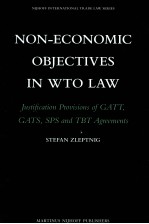图书介绍
Non-Economic Objectives in WTO LawPDF|Epub|txt|kindle电子书版本网盘下载

- 著
- 出版社: BRILL
- ISBN:9004178601;9004178600
- 出版时间:2009
- 标注页数:421页
- 文件大小:126MB
- 文件页数:441页
- 主题词:
PDF下载
下载说明
Non-Economic Objectives in WTO LawPDF格式电子书版下载
下载的文件为RAR压缩包。需要使用解压软件进行解压得到PDF格式图书。建议使用BT下载工具Free Download Manager进行下载,简称FDM(免费,没有广告,支持多平台)。本站资源全部打包为BT种子。所以需要使用专业的BT下载软件进行下载。如BitComet qBittorrent uTorrent等BT下载工具。迅雷目前由于本站不是热门资源。不推荐使用!后期资源热门了。安装了迅雷也可以迅雷进行下载!
(文件页数 要大于 标注页数,上中下等多册电子书除外)
注意:本站所有压缩包均有解压码: 点击下载压缩包解压工具
图书目录
Introduction1
Ⅰ.Purpose of this Study1
Ⅱ.Objective and Scope4
Ⅲ.Methodology5
Ⅳ.Structure9
PART ONE FUNDAMENTAL ISSUES15
Chapter One Free Trade and Its Limits15
Ⅰ.Introduction15
Ⅱ.The Case for Free Trade16
A. Free Trade Theory17
B. Protectionism21
C. Free Trade in a Wider Context24
D. Conclusion26
Ⅲ.Objections to Free Trade27
A. Economic Arguments28
B. Non-Economic Arguments32
Ⅳ.Conclusion53
Chapter Two The Potential and Limitations of Interpretation in WTO Law55
Ⅰ.Introduction55
Ⅱ.Interrelationship between WTO Law and Public International Law56
Ⅲ.Methods of Interpretation in WTO Law61
A. Article 3.2 DSU61
B. Articles 31 and 32 VCLT and their Application in WTO Law62
C. General Rule: Article 31 VCLT63
D. Article 31(3)(c) VCLT: Promoting the Coherence of International Law69
E. Article 32 VCLT: Supplementary Means of Interpretation77
F. Additional Principles of Treaty Interpretation78
Ⅳ.Conclusion82
Chapter Three The Role and Function of Non-Economic Exception Clauses in Trade Agreements85
Ⅰ.Introduction85
Ⅱ.Basic Principles and Objectives of Trade Agreements86
Ⅲ.Reasons for Non-Economic Exception Clauses88
A. Stability and Flexibility88
B. State Sovereignty and Allocation of Power89
C. Intrinsic Importance of Non-Economic Objectives93
D. Tensions Inherent in the System95
Ⅳ.Scope and Nature of Exception Clauses96
A. Striking the Right Balance96
B. Network of Corresponding “Rights” and “Obligations”98
Ⅴ.Conclusion99
Chapter Four Two Models of Non-Economic Justification Clauses in WTO Law: GATT/GATS versus SPS/TBT101
Ⅰ.Introduction101
Ⅱ.Non-Economic Exception Clauses in GATT and GATS:The“Traditional Approach”101
A. Classifying Exception Clauses: Economic versus Non-Economic Objectives101
B. Drafting History103
C. The Rule-Exception Relationship105
D. Justification as a Two-Tier Test112
Ⅲ.Non-Economic Justification Provisions in the SPS and TBT Agreements: The “New Approach”117
A. Background117
B. Regulatory Philosophy and Structure of the SPS and TBT Agreements: Justification Inherent in the Rules118
Ⅳ.Conclusion121
PART TWO NON-ECONOMIC JUSTIFICATION IN GATT AND GATS125
Chapter Five The Non-Economic Grounds of Justification in Art ⅩⅩ GATT and Art ⅩIⅣ GATS125
Ⅰ.Introductory Remarks125
A. Non-Economic Nature125
B. Autonomous Legal Concepts127
Ⅱ.Explicit Grounds of Justification128
A. Public Morals128
B. Public Order143
C. Human, Animal or Plant Life or Health149
D. Conservation of Exhaustible Natural Resources161
E. Securing Compliance with Laws or Regulations169
F. Other Grounds of Justification180
Ⅲ.Implicit Grounds of Justification182
A. Environment182
B. Human Rights189
C. Labour Standards204
D. Culture211
Chapter Six Substantive and Procedural Conditions for the Invocation of Art ⅩⅩ GATT and Art ⅩⅣ GATS225
Ⅰ.Introductory Remarks225
Ⅱ.Level of Protection225
A. Introduction225
B. Dispute Settlement Practice226
Ⅲ.Necessity Test229
A. Judicial Development of the Concept of “Necessity”230
B. Evaluation of the Necessity Test in a Comparative Context243
C. Lessons for the Necessity Test in WTO Law263
Ⅳ.“Relating to” Test265
A. Judicial Development266
B. Evaluation of the “Relating to” Test269
Ⅴ.Introductory Clause (“Chapeau”)272
A. Drafting History272
B. Purpose and Function of the Chapeau273
C. The Individual Requirements of the Chapeau278
D. Similar Concerns in the Second Sentence of Art 30 EC291
E. Evaluation295
Ⅵ.The Lawfulness of Trade Measures with Extraterritorial Focus297
A. Introduction297
B. “Unilateralism” and “Extraterritoriality”299
C. Trade Restrictions with Extraterritorial Focus: Exercise of Extraterritorial Jurisdiction?304
D. Evaluation under Art ⅩⅩ GATT and Art ⅩⅣ GATS308
E. Conclusion326
PART THREE NON-ECONOMIC JUSTIFICATION IN THE SPS AND TBT AGREEMENTS331
Chapter SevenNon-Economic Justification Provisions in the SPS Agreement331
Ⅰ.SPS Agreement331
A. Drafting History and Background332
B. Scope and Purpose333
C. Regulatory Philosophy335
Ⅱ.Relationship with GATT and other WTO Agreements338
Ⅲ.Grounds of Justification339
Ⅳ.Substantive and Procedural Requirements341
A. Basic Rights and Obligations341
B. Appropriate Level of Protection343
C. Scientific Justification350
D. Design and Application of SPS Measures355
Ⅴ.Standard of Review and Risk Regulation359
Ⅵ.Conclusion360
Chapter EightNon-Economic Justification Provisions in the TBT Agreement365
Ⅰ.TBT Agreement365
A. Drafting History and Background366
B. Scope and Purpose368
C. Regulatory Philosophy369
Ⅱ.Relationship with GATT and other WTO Agreements371
Ⅲ.Grounds of Justification373
A. Legitimate Objectives373
B. Trade Measures with Extraterritorial Focus374
Ⅳ.Substantive and Procedural Requirements375
A. Non-Discrimination375
B. Level of Protection375
C. Necessity376
D. Obligation to Use International Standards379
Ⅴ.Conclusion384
Overall Conclusion387
Bibliography399
Appendix: Relevant Treaty Provisions413
Index419